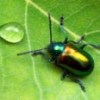Areolate
In 1979, Rick Harris wrote a definitive paper illustrating the various terms used by taxonomists to describe the intricate patterns on the insect exoskeleton. His guide is tremendously helpful to those of us who struggle to decide if those ridges on the head of an ant are strigate or costate. Via Sifolinia, I now see that Harris's illustrations are available online:
A Glossary of Surface Sculpturing
Incidentally, Rick was the guy who taught me how to use a Scanning Electron Microscope, although at this point it'd be a minor miracle if I remembered any of it.


Great. That site should be useful.
The pdf version is also available here:
http://www.cdfa.ca.gov/PHPPS/PPD/publications/occ_papers_ent.html
Yeah, the old standard. My problem with Harris (1979) - actually it's with the way people *use* that reference, rather than the reference itself - is that people try to force their sculpture of interest into the 35 or so terms that were illustrated, rather than perusing the extensive list (100+) of potentially more relevant terms that have textual descriptions but lack SEMs. I know I was guilty of that in the past. 'Cataphracted' (clad in closely set scales; cf. imbricate, scutate, squamate), for example, was not illustrated and therefore may get overlooked. The web resource you link to only lists the terms that were illustrated. The Hymenoptera Glossary lists ALL therms (http://hymglossary.tamu.edu/projects/32/public/ontology/show_term/589), but none are illustrated. We're working on that though!
This has been up for ten years on antbase/social insects WWW. Since you are such an dedicated imaging specialists. why aren't you taking the images down, adjust the gray values and then people can see the content much better. I alwys wanted to do it, but never came around to do it...
The page you refer has even been indedexed by the Library of Congress...
Hi Donat. That's not a bad idea. Are the ones on the web the highest-resolution files available, or have they been compressed from larger files? It wouldn't take more than an hour or two to do, but the end result will be better if I can work from the original scans.
I think, the originals are tiff, and scanned at 600dpi - I need to find them in my archive... and let you know
If you find them, Donat, burn them onto a CD and send them here. I can batch process them in photoshop.
how many times is this magnified???
COME ON I NEED THIS 4 SCHOOL!
I have the originals of the photos you are discussing. I have the original negatives, also. The negatives are 4x5 Polaroid. In the last 30 years since I printed those pictures, I have learned how to make a better print. My time is limited but if I can help create better images, I will. I have access to a large format negative scanner so, as time allows, I can scan the negatives and post them to Donat or anyone else.
Rick A. Harris
University of California,
Davis, CA
So did somebody work on the original files and are they available somewhere on the net (except the ones on antbase.org)?
cheers,
Jochen